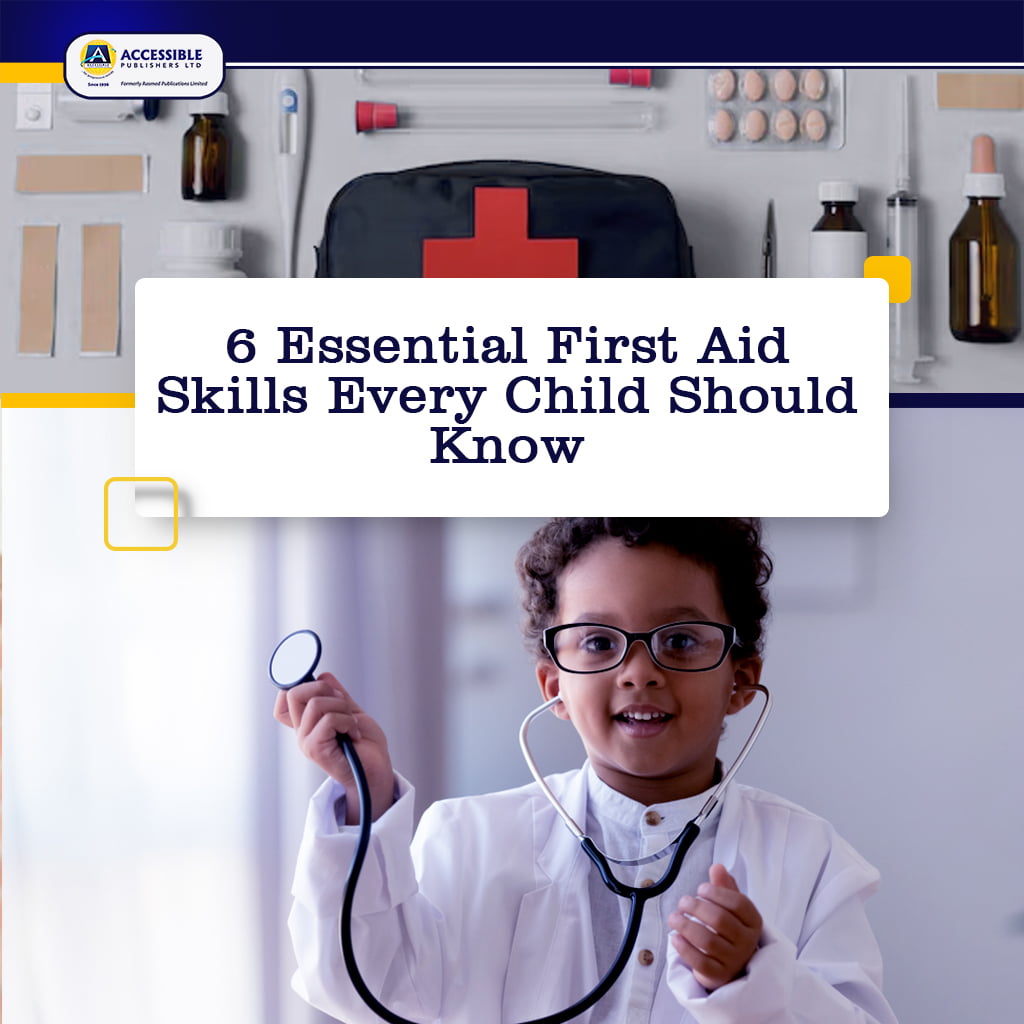Picture this: Your child confidently steps forward in a crisis, ready to save the day. Sounds like a superhero movie? It could be your reality!
In our whirlwind world of unpredictability, arming our kids with more than just book smarts is no longer optional—it’s a must. Enter the unsung hero of life skills: first aid.
Imagine the pride (and relief) you’d feel watching your little one spring into action, patching up a playground scrape or even stabilizing a situation until the pros arrive. It’s not just about bandages and antiseptic; it’s about moulding mini-heroes who keep cool under pressure.
By gifting our children the power of first aid knowledge, we’re not just potentially saving lives—we’re cultivating a generation of quick-thinking, level-headed problem solvers. These skills are their real-life superpowers, transforming them from bystanders to life-savers in the blink of an eye.
Ready to unlock your child’s inner hero? Buckle up! We’re about to explore six game-changing first aid skills that’ll turn your kiddo into the neighbourhood’s go-to guardian angel.
But first, let’s get our terminology straight. Before we leap into the action-packed world of kid-friendly first aid, let’s break down some key terms. Think of it as our superhero glossary—essential intel for the mission ahead!
Definition of Terms
- First Aid: The initial care provided to someone suffering from an injury or sudden illness before professional medical help arrives.
- Emergency: An unforeseen crisis demanding immediate action.
- CPR (Cardiopulmonary Resuscitation): A lifesaving technique used in emergencies when someone’s heartbeat or breathing has stopped.
Understanding these terms is crucial as they form the foundation of first aid knowledge. It is also important for children to understand the importance of first aid and how to apply it in real-life situations. This leads us to the importance of first aid knowledge for children.
The Importance of First Aid Knowledge For Children.
- Preparedness:
Children who know first aid can respond promptly and correctly during emergencies, reducing panic and increasing the likelihood of a positive outcome.
- Confidence:
First aid training boosts children’s confidence, helping them stay calm and collected under pressure.
- Responsibility:
Learning first aid instils a sense of responsibility and care for others, promoting empathy and community spirit.
- Safety Awareness:
First aid education increases awareness about potential hazards and safety practices, leading to a more cautious and informed approach to everyday activities.
- Career inspiration:
Early exposure to medical concepts may inspire future healthcare professionals.
There are lots of various First Aid skills that can be of benefit to every child, however, in this blog, we will be discussing six essential ones.
The Six Essential First Aid Skills
Here are six fundamental first-aid skills every child should learn:
Emergency Contact Protocol:
Children should know how to dial emergency numbers and provide essential information, such as their location, house address, names of their parents and the nature of the emergency. Practising this can make a significant difference in response times during actual emergencies.
Treating Minor Cuts and Scrapes:
Teaching children how to clean and dress minor wounds can prevent infections and complications. They should learn how to apply pressure to stop bleeding using a clean cloth. Also how to wash the area with clean water, apply antiseptic, and cover it with a bandage.
Dealing with Nosebleeds:
Nosebleeds are common, and children should know how to manage them. They should sit up straight, lean forward slightly, and pinch the soft part of their nose for about ten minutes to stop the bleeding.
Handling Burns:
Children should understand the importance of cooling a burn under running water for at least ten minutes and not applying ice or butter. They should also know to cover the burn with a clean cloth and seek medical help if necessary.
Performing CPR:
While full CPR certification might be too advanced for young children, they can learn the basics of chest compressions. Teaching them to apply pressure in the centre of the chest and push hard and fast can be lifesaving until professional help arrives.
Helping Someone who is Choking:
Children should recognize the signs of choking and know how to perform back blows and abdominal thrusts (Heimlich manoeuvre) to dislodge an obstruction. Demonstrating these techniques with age-appropriate guidance ensures they understand how to apply them safely.
In a country where medical facilities may not always be immediately accessible, these skills can bridge crucial gaps in emergency care.
In other words, mastering these essential first-aid skills is just the beginning. By equipping children with this knowledge, we create a foundation for them to grow into responsible and capable individuals who can handle emergencies with confidence.
To wrap up, as teachers or parents it’s our responsibility to integrate this practical knowledge into our children’s upbringing. Through engaging demonstrations, local community workshops, and consistent practice, we can ensure that these life-saving skills become second nature to our youth.
Let’s commit to creating a safer nation, one child at a time. By empowering our young ones with these vital first aid skills, we’re not just safeguarding individual lives; we’re building a more resilient, prepared, and caring nation for the future.
Check out our literature catalogue to discover an array of titles that can help motivate children to keep turning the pages. It’s time to explore and embark on an enriching literary journey.
Click this link to learn more about us here!







binance signup bonus
5 Aug 2024Your point of view caught my eye and was very interesting. Thanks. I have a question for you.
free binance account
22 Oct 2024Can you be more specific about the content of your article? After reading it, I still have some doubts. Hope you can help me.
创建个人账户
24 Nov 2024Your article helped me a lot, is there any more related content? Thanks!
Jamal Langolf
14 Dec 2024I’ve been searching for information like this for a while. Excellent post with lots of actionable advice! Your writing style makes this topic very engaging. Fantastic job covering this topic in such depth! Your perspective on this topic is refreshing!
Sign Up
5 Jan 2025Thanks for sharing. I read many of your blog posts, cool, your blog is very good.
binance
10 Jan 2025Thank you for your sharing. I am worried that I lack creative ideas. It is your article that makes me full of hope. Thank you. But, I have a question, can you help me?
Binance
11 Feb 2025Thank you for your sharing. I am worried that I lack creative ideas. It is your article that makes me full of hope. Thank you. But, I have a question, can you help me?
binance-
20 Mar 2025Thanks for sharing. I read many of your blog posts, cool, your blog is very good.
binance алдым-ау
4 Apr 2025Your point of view caught my eye and was very interesting. Thanks. I have a question for you.